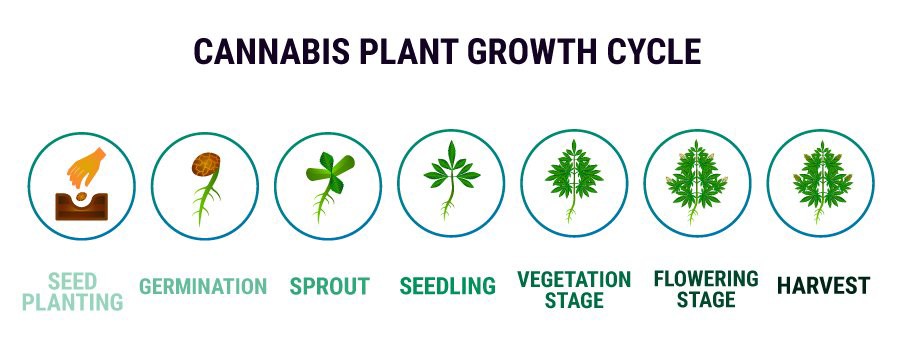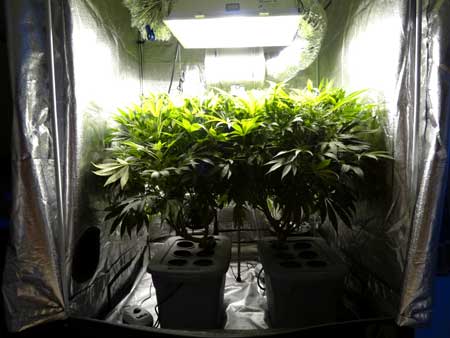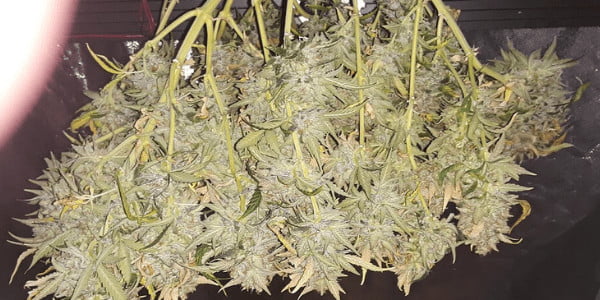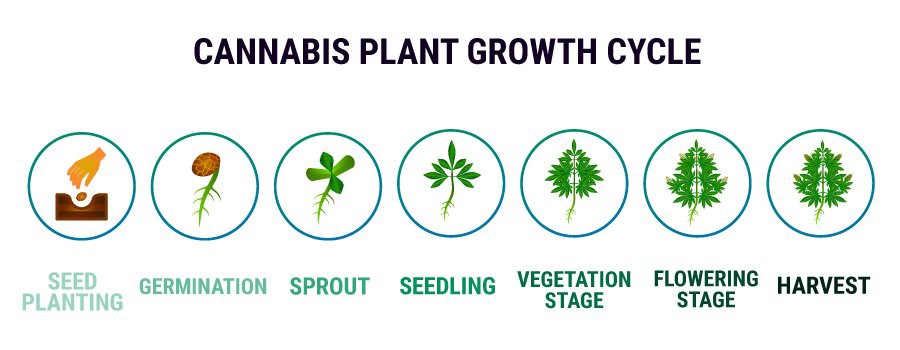Importance of Understanding the Marijuana Plant Stages of Growth
Understanding the different stages of the marijuana plant life cycle is essential for home and commercial growers alike. Each step of the cannabis plant requires specific care and attention to produce high-quality cannabis and address any issues that may arise. Cannabis contains over 100 cannabinoids, with THC being responsible for psychoactive effects and CBD having potential therapeutic benefits. Cannabis can be grown indoors and outdoors, and knowing the stages of growth is crucial for healthy and potent plants.
The 4 Different Marijuana Plant Growth Stages

Seedling Stage
During the cannabis seedling stage, the plant is in its most delicate state. It requires a moderate amount of light and warmth to grow correctly. At this stage, the plant develops its first set of true leaves, and its initial root system begins to take shape. It is essential to avoid overwatering during this stage, as too much moisture can stunt growth or even kill the plant. Proper nutrition through high-quality soil and nutrients is crucial to ensure healthy seedling development.
Vegetative Growth Stage
The plant develops its leaves, main stem, and branches in vegetative growth. It is crucial to provide the plant with sufficient light, nutrients, and water during this stage to promote healthy growth. Typically, this stage lasts 4-8 weeks, depending on the strain and growing conditions. Once the plant has reached its desired size, it can be induced to switch to the flowering stage by changing the light cycle. Overall, the vegetative growth stage is a critical phase in the cannabis plant’s life cycle, which sets the foundation for the plant’s overall health and yield.
Flowering Phase
During the marijuana flowering stage, the plant produces dense and fragrant buds. This stage is the most crucial period for marijuana growers as it directly affects the yield and potency of the plant. Depending on the strain and growing conditions, the flowering stage can last anywhere between 6 to 12 weeks. During this stage, growers should pay close attention to lighting, humidity, and temperature to ensure optimal growth. Once the buds have developed to their full potential, they can be harvested and prepared for consumption or further processing.
Harvesting & Curing
The Grand Finale! Cannabis harvesting and curing stage, growers aim to maximize the potency and flavor of the buds. The plant is ready to be cut down and trimmed to remove excess material, leaving only the flower. These flowers are then hung or laid out in a cool, dry place where they can slowly dry over several days to a few weeks. As the flowers dry, the THC and other cannabinoids become more concentrated, resulting in a stronger final product. Proper curing is essential for producing high-quality marijuana and can make a significant difference in the effects and taste of the final product.
The Cannabis Seedling Stage
The seedling stage is the first stage of cannabis growth, which begins when the seed germinates, and the plant emerges from the soil. During this stage, the plant will develop its first set of leaves called cotyledons. These leaves give the plant the energy it needs to grow until it can produce it through photosynthesis. The seedling stage typically lasts for two to three weeks, and during this time, it is vital to provide the plant with plenty of light, water, and nutrients to ensure healthy growth and a healthy cannabis plant in the future. Reminder: temperature and humidity levels to prevent issues such as mold or pests.
How long is a weed plant considered a seedling?
The seedling stage typically lasts for about two to three weeks. During this time, the plant will develop its first set of leaves and establish its root system. Providing the seedlings with proper lighting, humidity, and nutrients is vital to ensure healthy growth. Once the plant has developed a few leaves and is strong enough to handle more intense lighting, it can be transplanted into a larger container or directly into the ground. It is important to monitor the plant closely during this stage and make any necessary adjustments to ensure optimal growth.
What are the key characteristics of the seedling stage?
During the seedling stage, cannabis plants require much attention and care as they are highly susceptible to pests and diseases and are incredibly fragile. Maintaining the soil’s moisture level is crucial without causing waterlogging, as excessive watering can lead to root rot. Seedlings need ample light, but avoiding excessive direct sunlight exposure is equally vital, which can result in dehydration and damage. To ensure success in the seedling stage, it’s essential to provide the plant with the appropriate balance of nutrients, water, and light while protecting it from potential threats.
What is best for seedlings and germinating a cannabis seed?
During the seedling stage, it is crucial to provide your cannabis plants with the right amount of light, water, and nutrients. It is recommended to keep the temperature between 70-75°F and the humidity level between 60-70%. Overwatering can lead to root rot, so letting the soil dry out slightly before watering again is essential. It is also recommended to use a gentle fertilizer with a low concentration of nutrients. Additionally, it is crucial to keep the seedlings away from pests and diseases by maintaining a clean and sterile environment. With proper care during seedling, your cannabis plants will have a strong foundation for healthy growth and development.
Marijuana Vegetative Stage
What is the vegetative stage?
The vegetative stage is the period of cannabis growth where the plant focuses on developing its leaves, stems, and roots. During this stage, the plant requires a lot of light and nutrients to support its growth. Keeping the plant in a stable environment with a consistent light cycle is essential to ensure healthy growth. The vegetative stage can last from a few weeks to a few months, depending on the strain and growing conditions. Once the plant has reached its desired size, it will enter the flowering stage.

How long does the vegetative stage of the cannabis life cycle last?
The vegetative stage of cannabis growth can last anywhere from two to eight weeks, depending on the strain and growing conditions. The plant develops its roots, stems, and leaves during this stage. Ensure you provide the plant with adequate light, nutrients, and water during this stage to ensure healthy growth. Once the plant has reached the desired size, it can be switched to the flowering stage by adjusting the light cycle. It is important to note that some growers may extend the vegetative stage to achieve larger plants with more buds.
What are the key characteristics of the vegetative stage?
During the vegetative stage, cannabis plants focus on growing their leaves, stems, and roots. They require a lot of light, water, and nutrients to support their growth. The plants will grow taller and wider during this stage, and their leaves will become more prominent. Monitor the plants closely during this stage to ensure they receive the proper care and nutrients they need to thrive. The vegetative stage typically lasts four to eight weeks, depending on the strain and growing conditions. Once the plants have reached the desired size, they will enter the flowering stage.
What are the best practices for caring for cannabis plants in the vegetative stage?
Providing your cannabis plants with the right amount of light, nutrients, and water. The ideal light cycle during this stage is 18 hours of light and 6 hours of darkness. Keep the temperature between 70-85°F and the humidity between 40-70%. Monitoring the soil’s or hydroponic solution’s pH levels and adjusting accordingly is critical to success in all gardens. Pruning and training techniques can also be applied during this stage to promote healthy growth and increase yields. Overall, providing your cannabis plants with a healthy and stable environment during the vegetative stage will set them up for a successful flowering stage.
Marijuana Flowering Stage
What is the flowering stage?
The flowering stage is the most crucial in cannabis growth as it is during this time that the plant produces buds. This stage typically occurs after the vegetative stage, and it can last anywhere from 6 to 12 weeks, depending on the strain. During this stage, the plant requires a specific light cycle of 12 hours of light and 12 hours of darkness to trigger the flowering process. Maintaining proper humidity and temperature levels is essential to ensure healthy bud growth. The buds will continue to grow and mature until they are ready for harvest, typically indicated by the appearance of amber-colored trichomes.
Marijuana Flowering Stage Time Lapse Video
How long does the flowering stage last?
The flowering stage is the most crucial in the cannabis growth cycle as it is during this stage the plant produces the buds that contain the psychoactive compounds. The duration of the flowering stage varies depending on the strain and the growing conditions. Typically, the flowering stage lasts 6 to 12 weeks, with some cultivars (strains) taking up to 16 weeks to complete. Staying diligent and keeping the environment as dialed in as possible will help ensure a successful harvest while avoiding potential last-inning problems. Once the buds have fully matured, they can be harvested and dried for consumption.
What are the key characteristics of the flowering stage?
The flowering stage is the most crucial stage of cannabis growth as it determines the quality and quantity of the buds. During this stage, the plant will produce flowers or buds containing the highest cannabinoids and terpenes. The buds will start developing trichomes, tiny resin glands containing the plant’s active compounds. The plant will also emit a strong aroma, depending on the strain. Depending on the strain and growing conditions, the flowering stage can last 6 to 12 weeks.
What are the best practices for caring for cannabis plants in the flowering stage?
Continuing a proper nutrient diet for your cannabis plants throughout the flowering period helps maintain and build all the coveted essential oils, colors, and mass that every grower looks forward to before harvesting their garden. However, monitoring your grow room’s humidity and temperature is also crucial. High humidity levels can lead to mold and mildew growth, while low humidity levels can cause the plants to dry out. Additionally, it is important to keep a close eye on the pH levels of the soil or hydroponic solution to ensure that the plants can absorb the nutrients they need. Finally, regularly inspect your plants for any signs of pests or diseases and take action immediately if necessary. With proper care during the flowering stage, you can ensure a healthy and bountiful harvest.
Harvesting and Curing Weed
What is harvesting?
Harvesting is the process of cutting down and collecting mature cannabis plants. This is a crucial step in the cultivation process as it determines the potency and quality of the final product. Harvesting should be done at the right time when the trichomes, which contain the cannabinoids and terpenes, are at their peak. The timing of harvesting can vary depending on the strain and growing conditions. Handling plants with care during harvesting to avoid damaging the buds and compromising the quality of the final product. Once harvested, the plants must be dried and cured before they can be used for consumption.
What is curing?
Curing is drying and aging harvested cannabis buds to enhance their flavor, aroma, and potency. It involves storing the buds in a controlled environment with a specific temperature and humidity level for several weeks to months. During this time, the buds release excess moisture and break down chlorophyll, which can cause a harsh taste and smell. Curing also allows the buds to develop a smoother smoke and a more potent high. Proper curing is essential for producing high-quality cannabis that is enjoyable to consume.
Why are harvesting and curing important?
Harvesting and curing are crucial steps in the cannabis cultivation process. Harvesting involves cutting down the mature plants and removing the leaves and buds from the stems. Conversely, curing involves drying and aging the buds to enhance their flavor, aroma, and potency. Proper harvesting and curing techniques can significantly improve the quality of the final product. Harvesting at the right time is important to ensure maximum potency and yield. Curing also helps to remove excess moisture from the buds, preventing mold and mildew growth. Proper harvesting and curing can make a significant difference in the quality of the final product, making it more enjoyable and effective for consumers.

When to Harvest Cannabis
What are the best practices for harvesting and curing cannabis plants?
Harvesting and curing cannabis plants is a crucial step in the cultivation process. The best time to harvest cannabis plants is when the trichomes, or resin glands, have turned from clear to milky white or amber. This indicates that the plant has reached its peak potency. After harvesting, the plants should be hung upside down in a cool, dark, and dry room for about a week for proper drying. Once the buds are dry, they should be trimmed and placed in airtight containers to cure for several weeks.
Curing allows the buds to develop their full flavor and aroma while improving their potency. It’s important to monitor the humidity levels during the curing process to prevent mold growth. Proper harvesting and curing techniques can enhance the quality of the final product.
Different Stages of Cannabis Plant Life Cycle
Understanding the four primary stages of cannabis growth is crucial for successful cultivation. These stages are germination, seedling, vegetative, and flowering. In the germination stage, the seeds sprout and develop their roots. The plant’s stem develops during the seedling stage, and the first leaves emerge. The vegetative stage follows, characterized by a rapid growth spurt with the plant developing more branches and leaves. Finally, in the flowering stage, the plant produces buds and is ready for harvesting. Each stage requires specific care and attention to ensure maximum growth and yield, making it important to have a clear understanding of each stage of marijuana growth.
Marijuana Plant Stages Life Cycle FAQs
What are the stages of marijuana growth?
The stages of marijuana growth are germination, seedling, vegetative, flowering, and harvesting.
How long does each stage last?
The length of each stage can vary depending on environmental factors and the strain of marijuana being grown. Germination can take anywhere from 1-10 days, the seedling stage can last 3-6 weeks, the vegetative stage can last 1-2 months, and the flowering stage can last 6-10 weeks or longer.
What environmental factors are important during each stage of growth?
During the seedling and vegetative stages, it is important to maintain a temperature of 77 degrees, proper humidity, and limit nutrient intake. During the flowering stage, it is important to change the light cycle to 12 hours on and 12 hours off, maintain a temperature of 68-77 degrees, and stop fertilizing 10 days before maturity.
How can you tell when marijuana is ready for harvest?
You can tell when marijuana is ready for harvest by looking at the pistils. When 50-70% of the pistils are brown, the plant is ready for harvest but still young. When 70-90% of the pistils are brown, the taste and effect peak and maximum potency has been achieved. When 90-100% of the pistils are brown, it is almost too late to harvest, the taste is heavy, and the effect is narcotic.
Final thoughts on understanding cannabis growth stages
Understanding cannabis growth stages is vital for all growers, regardless of experience. The proper nutrients, lighting, and environment are crucial for quality and yield. Each strain has unique growth traits, so researching their specific requirements is essential. Patience, knowledge, and attention to detail lead to successful cultivation.
If you want to grow cannabis, this article can help you learn about the different stages of growth. ParamountSeedFarms.com is a great resource for high-quality seeds and advice, whether experienced or new to growing. Check out their selection of seeds and start your journey today. It’s important to start growing as soon as possible.

